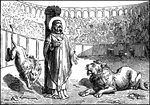Clipart tagged: ‘colosseum’

Roman Colosseum
This Roman Colosseum is located in Rome, Italy. It is the largest elliptical amphitheater that was built…

Gladiators
This illustration shows various types of gladiators, each type with with his specific weapons attributed…

Ignatius of Antioch is Martyred by Being Fed to Lions
Illustration of Ignatius of Antioch, also called Ignatius Theophorus, tied to a post by his neck and…
